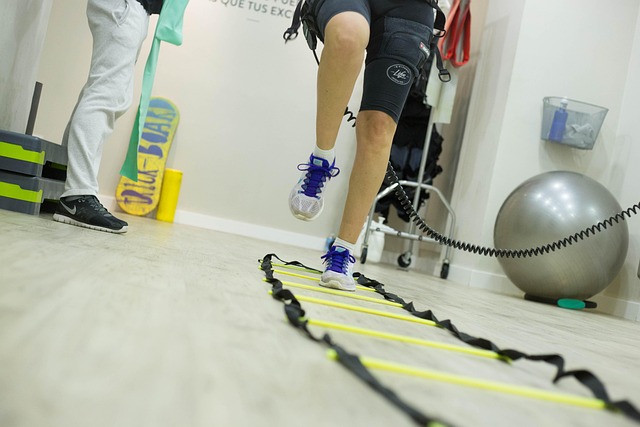Sleep is a vital component of workplace wellness initiatives, impacting physical and mental health, energy levels, and job satisfaction. Evaluating sleep habits and environment is key, focusing on consistent schedules, optimizing bedrooms, and adopting relaxing rituals. Implementing strategies like regular breaks, ergonomic setups, and stress management improves sleep quality. Integrating sleep initiatives into workplace programs enhances recovery, boosts productivity, and fosters a positive organizational culture that values holistic well-being across various industries.
Sleep is a powerful tool for enhancing recovery and boosting energy levels, crucial aspects for optimal workplace performance. This article delves into the science behind sleep’s role in rejuvenation, guiding you through actionable steps to transform your sleep habits. We explore evaluative methods to assess your current environment and offer practical strategies for improvement. Furthermore, we discuss integrating effective sleep initiatives into workplace wellness programs, fostering a culture of rest and productivity.
- Understanding Sleep's Role in Recovery and Energy Levels
- Evaluating Your Current Sleep Habits and Environment
- Implementing Effective Sleep Improvement Strategies
- Integrating Sleep Initiatives into Workplace Wellness Programs
Understanding Sleep's Role in Recovery and Energy Levels

Sleep is a fundamental pillar of overall health, playing a pivotal role in both physical and mental recovery. When we sleep well, our bodies undergo crucial restorative processes, including muscle repair, hormone regulation, and immune system strengthening. This direct correlation between quality sleep and enhanced energy levels is why integrating effective sleep habits is essential for successful workplace wellness initiatives.
In today’s fast-paced work environments, where long hours and high-stress levels are common, prioritizing sleep can often be overlooked. However, implementing strategies to improve sleep quality should be at the forefront of any comprehensive workplace wellness program. By fostering a culture that values rest and recovery, organizations can ultimately boost employee productivity, morale, and overall job satisfaction.
Evaluating Your Current Sleep Habits and Environment

Evaluating your current sleep habits and environment is a crucial step in crafting an effective sleep improvement plan. Start by observing your daily routines, especially those that impact your bedtime and wake-up times. Do you struggle to switch off before sleep? Are there distractions like electronic devices or a noisy surroundings disrupting your rest? Your bedroom should be a sanctuary for sleep, promoting relaxation through cool temperatures, minimal light, and comfortable bedding.
Consider also the role of workplace wellness initiatives in shaping your sleep patterns. Long working hours or stressful jobs can lead to poor sleep quality. Implementing strategies that integrate workplace wellness, such as regular breaks, ergonomic setups, and stress management techniques, can positively influence your overall sleep environment.
Implementing Effective Sleep Improvement Strategies

Implementing effective sleep improvement strategies is a game-changer for enhancing recovery and boosting energy levels, especially within the context of workplace wellness initiatives. Start by establishing a consistent sleep schedule; going to bed and waking up at the same time daily helps regulate your body’s internal clock. Ensure your bedroom is optimized for sleep, maintaining cool, dark, and quiet conditions. Consider incorporating relaxing bedtime rituals like reading or practicing mindfulness to signal to your body that it’s time to wind down.
Additionally, be mindful of your pre-sleep habits. Avoid stimulating activities and screens close to bedtime, as the blue light emitted can disrupt your natural sleep cycle. Instead, opt for calming activities such as journaling, listening to soothing music, or taking a warm bath. These adjustments, when integrated into your routine, can significantly contribute to improved sleep quality, leaving you refreshed and energized for the challenges ahead.
Integrating Sleep Initiatives into Workplace Wellness Programs

In today’s fast-paced work environments, integrating sleep initiatives into workplace wellness programs is becoming increasingly vital. By promoting healthy sleep habits, organizations can significantly enhance employee recovery and energy levels, leading to improved productivity and overall job satisfaction. Simple strategies such as encouraging regular sleep schedules, creating dark and quiet workspaces, and providing educational resources on sleep hygiene can make a substantial difference. These practices not only benefit individuals but also contribute to a positive organizational culture that values holistic well-being.
Workplace wellness initiatives focused on sleep can be tailored to suit various industries and job roles. For example, tech companies might implement flexible work schedules and quiet spaces for focused work, while healthcare organizations could offer specialized sleep workshops or access to telemedicine services for sleep-related issues. By making sleep a priority, businesses can foster an environment where employees feel supported in their pursuit of optimal rest, ultimately driving better performance and a happier workforce.
Sleep is a powerful tool for enhancing recovery and boosting energy levels, making it a key component of any successful workplace wellness initiative. By understanding the critical role sleep plays in our body’s restoration process, evaluating our current sleep habits, and implementing effective strategies, we can significantly improve our overall well-being. Integrating these sleep improvement plans into workplace wellness programs not only benefits individuals but also contributes to increased productivity and a happier, healthier workforce.
